Lontar of Bali
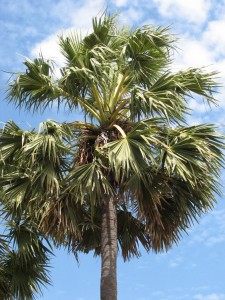 Lontar – The word ‘lontar’ is derived from two Old Javanese words, being ‘ron’ (leaf) and ‘tal’ (rontal tree). The word ‘rontal’ therefore means ‘leaf of the rontal tree’. The rontal tree belongs to the family of palm trees (Borassus fabellifer).
Lontar – The word ‘lontar’ is derived from two Old Javanese words, being ‘ron’ (leaf) and ‘tal’ (rontal tree). The word ‘rontal’ therefore means ‘leaf of the rontal tree’. The rontal tree belongs to the family of palm trees (Borassus fabellifer).
Due to the shape of its leaves, which are spread like a fan, these trees are also known as ‘fan trees’.
The leaves of the rontal tree have always been used for many purposes, such as for the making of plaited mats, palm sugar wrappers, water scoops, ornaments, ritual tools, and writing material.
The making of lontar leaf paper
In order to produce lontar leaf paper, first of all suitable leaves must be collected, ideally those of approximately 25 cm of length. The leaves are dried for one day, after which the rib of the leaves are cut out. Then the leaves are soaked with water during a length of three days, in order to remove the chlorofyl. The next step is to clean the leaves with a brush of coconut fibre, to remove dirt and the eggs of insects. After the cleaning the leaves are dried again for one day. Then the leaves are steamed above boiling water mixed with liligundi leaves and gambir (uncaria), in order to give the lontar their subtle yellowish-red color. Then the leaves are dried again. In order to prevent the leaves from wrinkling and being hard to flatten, the drying process is done slowly and in a damp place. As soon as the leaves are supple they are piled up one by one and flattened with a specially therefore designed press. An already completed lontar is used to define the correct lenghth, and then a cempurit (a special perforating device) is used to perforate the leaves in three designated places. Finally each lontar leaf is bound and pressed tighter with the use of screws, their edges are refined with a plane and the tips are cut to make them precisely even. Kincu or paint is used to color the lontar in red, after which the lontar are kept for six months before they are ready for inscriptions.
Inscription tools
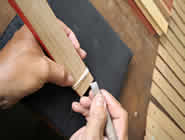 Lontar are inscribed with a special tool called pengerupak. It is made of iron, with its tip sharpened in a trangular shape so it can make both thick and thin inscriptions. There are two types of pengerupak, one for writing and one for drawing. The pengerupak for writing is approxemately 15 in length and 1.5 cm wide, the pengerupak for drawing has the same length but is only 0.5 – 1 cm wide. There also is a third, longer type which is used for the cutting of rontar leaves.
Lontar are inscribed with a special tool called pengerupak. It is made of iron, with its tip sharpened in a trangular shape so it can make both thick and thin inscriptions. There are two types of pengerupak, one for writing and one for drawing. The pengerupak for writing is approxemately 15 in length and 1.5 cm wide, the pengerupak for drawing has the same length but is only 0.5 – 1 cm wide. There also is a third, longer type which is used for the cutting of rontar leaves.
Lontar classification
The subjects that are dealt with in the lontar cover a variety of aspects of human life. These can be classified as follows:
- Weda lontar (Holy Books), written in Sanskrit, Old Javanese and Balinese
- Mantra, incantations originating from Java and Bali
- Kalpasastra, lontar dealing with religious rituals
- Palakerta, dealing with rules and regulations. These can also be found in the books of Dharmasastra, Kerta Sima, and Awig-awig (written and unwritten customary village laws)
- Agama lontar – religious rules, laws, regulations, ethics and morals
- Sasana, guidelines for ethics and morals
- Niti, dealing with juridical systems
- Usada lontar (homeopathy and healing)
- Usada deals with homeopathy and healing, such as Bodhakcapi, Dalem, Kuda, and others
- Wariga lontar (astronomy and astrology)
- Wariga, dealing with astronomy and astrology
- Tutur and Upasdesa, dealing with spiritual science of the universe
- Kanda, dealing with language, mythology, architecture, and other special subjects
- Itahasa lontar (epics)
- Parwa, epics in prose form
- Kakawin, epics based on old Indian rhythms
- Kindung, literature in Balinese, composed with a macepat rhythm, e.g. Sinom and Pangkur
- Pamancangah, dealing with genealogy
- Babad lontar (history and genealogy)
- Stories with a historical aspect, such as Panji Wijaya Krama and Rangga-Lawe, covering the period of the Majapahit Kingdom up to the rebellion of Rangga-Lawe
- Stories of the falling of the Kingdoms in song form, such as Rusak Buleleng
- Lelampahan lontar (performing arts)
- Kekawin, Ramayana, Bharata Yuddha, Bomakawya, Arjunawiwawa, a.o.Stories from ‘Kekawin’ take the classical form, which is called Wayang Purba in Northern Bali, stories derived from ‘Kidung’ take the Wayang Panji form, and stories from ‘Parwa’ take the Wayang Parba form.
- Tantri lontar (stories and notes)
- Tantra Kamandala, stories from ancient Indian literature, written in Sanskrit
- Satua Pengatihan Bali, stories containing Tantric influences or indigenuous Balinese.
- Surat Pengeling-eling, notes written by Royalty and scholars.
- Stories from the performing arts, such as Gambuh, Arja, etc.
- Prasi lontar (illustrated lontar)
The illustrations on these lontar are deried from wayang (shadow puppet plays). The wayang drawings on these lontars can be classified into five groups, based on the stories they tell:- Kidung, Jayendria, Damputi-Lelangan, Tantri, Brama Pasangupati, a.o.
- Parwa-parwa, such as Adiparwa
- Cerita Tantri, telling the story of King Asmaryadapala’s experiences with Dyah Tantri.
- Animal Fables

Fragment from Ramayana Kakawin
The unique Gedung Kirtya lontar library annex museum in Singaraja collects, copies and preserves thousands of lontar, and also “prasati” (transcriptions on metal plates) and books which deal with a variety of aspects of human life, such as religion, architecture, philosophy, genealogy, homeopathy, “usada” (medical manuscripts), black magic, and so on, in the Balinese, Kawi (old Javanese) and the Dutch, English and German language.
+ Read more about the Gedung Kirtya lontar library of Singaraja
Further reading
More information on lontar can be found at the web site of Lontar Library

share this article


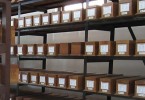
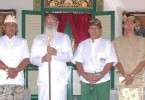
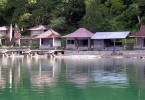
[…] Lontar book-The word ‘lontar’ is derived from two Old Javanese words, being ‘ron’ (leaf) and ‘tal’ (rontal tree). The word ‘rontal’ therefore means ‘leaf of the rontal tree’. The rontal tree belongs to the family of palm trees (Borassus fabellifer). Discover more […]